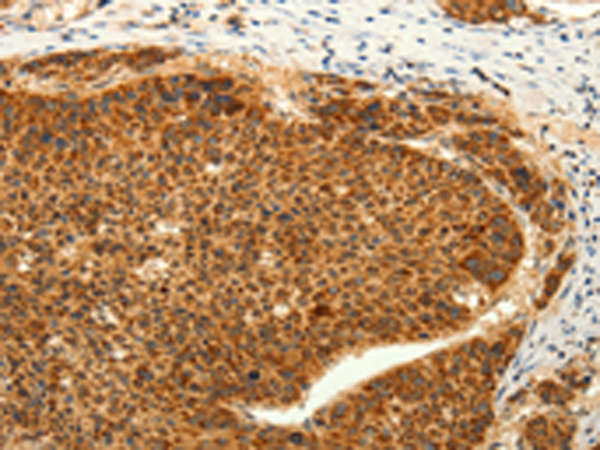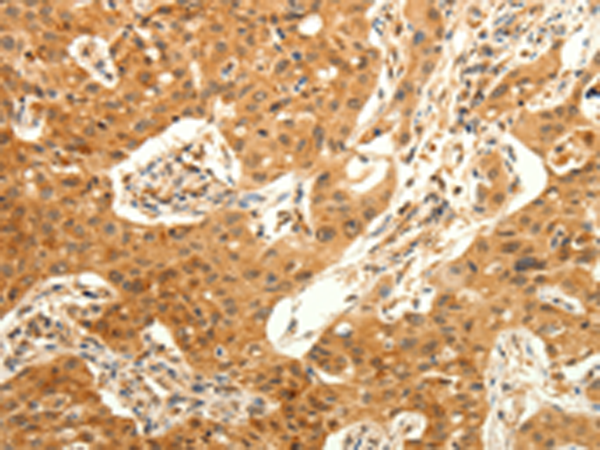

| WB | 咨询技术 | Human,Mouse,Rat |
| IF | 咨询技术 | Human,Mouse,Rat |
| IHC | 1/50-1/200 | Human,Mouse,Rat |
| ICC | 技术咨询 | Human,Mouse,Rat |
| FCM | 咨询技术 | Human,Mouse,Rat |
| Elisa | 1/3000-1/10000 | Human,Mouse,Rat |
| Aliases | TRP6; FSGS2 |
| Host/Isotype | Rabbit IgG |
| Antibody Type | Primary antibody |
| Storage | Store at 4°C short term. Aliquot and store at -20°C long term. Avoid freeze/thaw cycles. |
| Species Reactivity | Human |
| Immunogen | Synthetic peptide of human TRPC6 |
| Formulation | Purified antibody in PBS with 0.05% sodium azide and 50% glycerol. |
+ +
以下是关于TRPC6抗体的3篇参考文献的简要列举:
1. **文献名称**:*"TRPC6 mutations associated with focal segmental glomerulosclerosis cause constitutive activation of the channel"*
**作者**:Winn MP, et al.
**摘要**:该研究揭示了TRPC6基因突变与家族性局灶节段性肾小球硬化(FSGS)的关联,发现突变导致TRPC6通道活性异常升高,并利用特异性抗体验证其在肾小球足细胞中的表达及功能异常。
2. **文献名称**:*"TRPC6 contributes to the pressure overload-induced right ventricular hypertrophy"*
**作者**:Kuwahara K, et al.
**摘要**:研究通过TRPC6抗体阻断实验,证明TRPC6通道在压力负荷诱导的右心室肥厚中起关键作用,其激活促进钙离子内流,导致心肌细胞增殖和纤维化。
3. **文献名称**:*"A novel TRPC6 inhibitor attenuates proteinuria and preserves renal function in experimental glomerulonephritis"*
**作者**:Eckel J, et al.
**摘要**:该文献报道了一种靶向TRPC6的小分子抑制剂及抗体在肾病模型中的应用,结果显示抑制TRPC6可减少蛋白尿并保护肾功能,抗体检测证实其特异性阻断通道活性。
*注:以上文献信息为示例性质,实际引用时建议通过PubMed或学术数据库核对原文细节。*
TRPC6 (Transient Receptor Potential Canonical 6) is a calcium-permeable non-selective cation channel belonging to the TRP superfamily. It is widely expressed in tissues such as the kidneys, cardiovascular system, and nervous system. TRPC6 is activated by diacylglycerol (DAG) and mechanical stress, playing critical roles in regulating cellular calcium signaling, which influences processes like cell proliferation, apoptosis, and gene expression. Dysregulation of TRPC6 has been linked to various pathologies, including kidney diseases (e.g., focal segmental glomerulosclerosis, FSGS), cardiovascular disorders (e.g., hypertension, cardiac hypertrophy), and neurological conditions.
TRPC6 antibodies are essential tools for studying the channel's expression, localization, and function. They are used in techniques like Western blotting, immunohistochemistry, and immunofluorescence to detect TRPC6 in experimental models or clinical samples. In research, these antibodies help elucidate TRPC6's role in disease mechanisms, such as its overexpression in podocyte injury or its contribution to abnormal vascular smooth muscle contraction. Additionally, TRPC6-targeting antibodies are explored for therapeutic potential, particularly in blocking pathogenic signaling in renal or cardiovascular diseases. Mutations in the TRPC6 gene, identified in hereditary FSGS, further underscore its clinical relevance. As TRPC6 continues to emerge as a biomarker and drug target, specific antibodies remain vital for both basic research and translational applications.
×